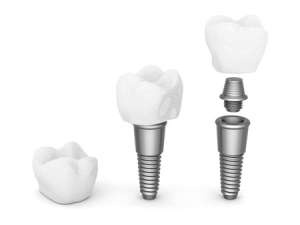
Dental Implant Crowns
 Dental implants are currently the best form of replacement of missing teeth in the field of dentistry. Unlike bridges and dentures, implants replace both, the crown as well as the root portion of the tooth thus protecting the structural integrity of the underlying bone. However, the procedure is surgically invasive and there are certain medical factors that are taken into consideration before deeming a patient eligible for the procedure.
Dental implants are currently the best form of replacement of missing teeth in the field of dentistry. Unlike bridges and dentures, implants replace both, the crown as well as the root portion of the tooth thus protecting the structural integrity of the underlying bone. However, the procedure is surgically invasive and there are certain medical factors that are taken into consideration before deeming a patient eligible for the procedure.
There are three parts of a conventional dental implant, namely implant, abutment and crown. The implant portion is fitted into the alveolar bone with the help of specialized instruments; the purpose of this component is to integrate with the surrounding bone to give a firm anchor to the entire unit – this process is called ‘Osseo-integration’. The Abutment is fitted atop the implant and it is on this component that the crown will later be seated. The crown, as the name indicates is the visible portion of the implant in the mouth – it replaces the crown of the natural missing tooth and restores functions such as chewing, biting, speech, and even aesthetics.
Some of the ways in which dental implants differ from other missing teeth replacement procedures in dentistry include:
- Replacement of the entire tooth as a whole (crown + root), instead of only the crown, such as in case of dentures and bridges.
- Protection and preservation of underlying bone, thus maintaining facial muscle tone.
- Permanent, fixed and immovable
- Highly aesthetically pleasing – looks exactly like a natural tooth in the oral cavity
- Expensive as compared to dentures and bridges
- Invasive surgical procedure
- Safe, biocompatible and non-toxic
- Outstanding strength – Can bear the load of all masticatory forces without fracturing
Because it takes a considerable amount of time for the implant to integrate with the surrounding bone, it may, in some cases, take up to 3 months for the procedure to get completed. However, Osseo-integration is critical for the success of an implant, because if an implant is loaded before it achieves ideal Osseo-integration, it may lead to the failure of the surgery eventually resulting in the dislodgement of the implant from the socket.
Do you have a few empty sockets in your mouth? Would you like to have your missing teeth replaced with the best quality implants available today? Book an appointment with the George Turner DDS for an unbelievable smile redesign!
